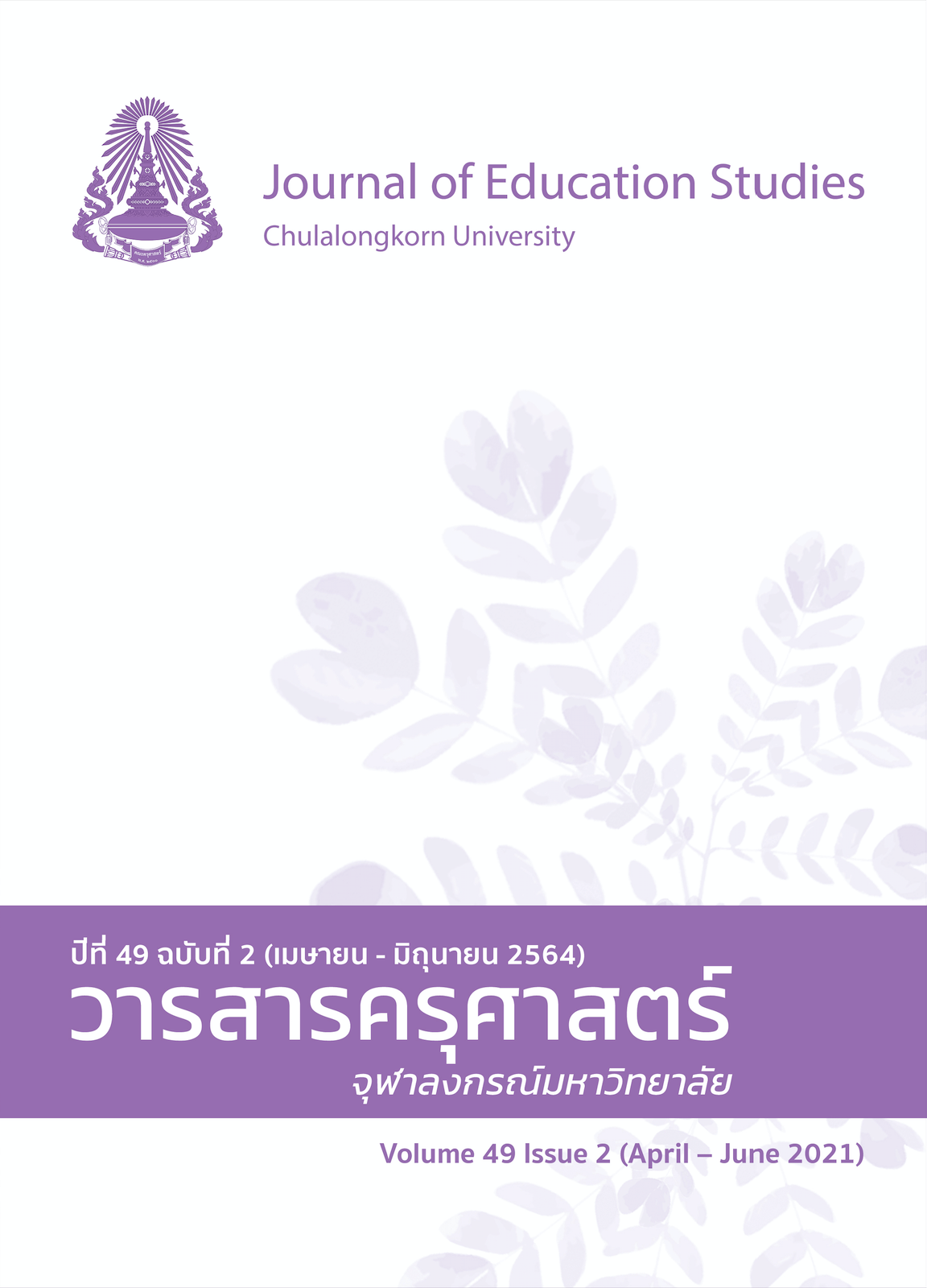A Study of Management for Private Schools According to the Concept of the Organization that Enhances Engagement of Teachers and Students
DOI:
https://doi.org/10.14456/educu.2021.24Keywords:
private school, organization that enhances engagement, teacher engagement, students’ engagementAbstract
The objectives of this research were to: 1) Study the conceptual framework of private schools that enhances the engagement of teachers and students; 2) Identify the current and desired states and needs of private school management; and 3) Using the SWOT analysis technique, analyse the Strengths, Weaknesses, Opportunities and Threats to private schools management according to the concept of organization that enhances the engagement of teachers and students. The sample consisted of 330 private schools, and the 873 respondents comprised administrators, teachers and students. The research study’s instruments included questionnaires and evaluation forms, and the data were analysed by means, standard deviation and a Modified Priority Needs Index (PNImodified). Findings showed that: 1) The conceptual framework of schools that enhance engagement comprised 6 elements, namely: Meaningful work; hands-on management; positive work environment; growth opportunities; trust in leadership, and equity. 2) Overall, the current management of private schools, according to the concept of the organization that enhances engagement of teachers’ and students’ states, was high, and the desired state of management was at the highest level. 3) The strength was ‘trust in leadership’, while the weakness was ‘growth opportunities for both teachers and students. Opportunities were ‘society’ and ‘technology’, while threats were ‘politics and government policy’ and
‘the economy’.
References
บัณฑิตย์ ศรีพุทธางกูร. (2558). วิกฤต โรงเรียนเอกชนไทยเสียง...สะท้อนที่ ศธ.ต้องฟัง. มติชนสุดสัปดาห์, 35(1795).
สำนักงานเลขาธิการสภาการศึกษา. (2559). ปฏิรูปการศึกษาเพื่ออนาคตประเทศไทย มั่นคง มั่งคั่ง ยั่งยืน นโยบายด้านการศึกษาของนายกรัฐมนตรี (พลเอก ประยุทธ์ จันทร์โอชา). 21 เซ็นจูรี่.
สุกัญญา รัศมีธรรมโชติ. (2556). ผูกใจพนักงานอย่างไรให้ได้ทั้งใจทั้งงาน : Employee engagement in practice. สถาบันเพิ่มผลผลิตแห่งชาติ สถาบันเครือข่ายของกระทรวงอุตสาหกรรม.
สุวิมล ว่องวาณิช. (2558). การวิจัยประเมินความต้องการจำเป็น (พิมพ์ครั้งที่ 3 ฉบับปรับปรุง). สำนักพิมพ์แห่งจุฬาลงกรณ์มหาวิทยาลัย.
ภาษาอังกฤษ
Bakker, A. B., & Demerouti, E. (2008). Toward a model of work engagement. Career Development International, 13(3), 209-223. https://doi.org/10.1108/13620430810870476
Bersin, J. (2015). Becoming irresistible: A new model for employee engagement. Deloitte Review, 16, 148-161.
Carbonara, S. (2013). Manager’s guide to employee engagement. McGraw-Hill.
Connell, J. P., Spencer, M. B., & Aber, J. L. (1994). Educational risk and resilience in African-American youth: Context, self, action and outcomes in school. Child Development, 65(2), 493-506.
Connell, J. P., & Wellborn, J. G. (1991). Competence, autonomy and relatedness: A motivational analysis of self-system processes. In M. Gunnar & L. A. Sroufe (Eds.), Minnesota symposium on child psychology (pp. 43-47). University of Chicago.
Fredricks, J. A., Blumenfeld, P. C., & Paris, A. H. (2004). School engagement: Potential of the concept, state of the evidence. Review of Educational Research, 74(1), 59-109.
Herzberg, F., Mausner, B., & Snyderman, B. B. (1959). The motivation (2nd ed.). John Wiley & Sons.
Marks, H. M. (2000). Student engagement in instructional activity: Pattern in the elementary, middle and high school years. American Educational Research Journal, 37(1), 153-184.
Mowday, R. T., Porter, R. W., & Steers, R. M. (1982). Employee–organization linkages: The psychology of commitment, absenteeism and turnover. Academic.
Newmann, F. M., Wehlage, G. G., & Lamborn, S. D. (1992). The significance and sources of student engagement. In F. Newmann (Ed.), Student engagement and achievement in American secondary schools (pp. 11-39). Teachers College.
Saks, A. M. (2006). Antecedents and consequences of employee engagement. Journal of Managerial Psychology, 21(7), 600-619. https://doi.org/10.1108/02683940610690169
Schaufeli, W. B. (2006). The balance of give and take: Toward a social exchange model of burnout. International Review of Social Psychology, 19(1), 87-131.
Sirota, D., Mischkind, L. A., & Meltzer, M. I. (2005). The enthusiastic employee. Wharton School.
Skinner, E. A., Zimmer-Gembeck, M. L., & Connell, J. P. (1998). Individual differences and the development of perceived control. Monographs of the Society for Research in Child Development, 63(2/3), I-231. https://doi.org/10.2307/1166220
Steers, R. M., & Porter, L. W. (1983). Motivation and work behavior (5th ed.). McGraw–Hill.
Swann, M., Peacock, D. A., Hart, S., & Drummond, M. J. (2012). Creating learning without limits. Mc Graw Hill.
Voke, H. (2002). Student engagement: Motivating student to learn. Association for Supervision and Curriculum Development.
Wellins, R.S., Bernthal, P., & Phelps, M. (2015). Employee engagement: The key to realizing competitive advantage. DDI. https://www.ddiworld.com/DDIWorld/media/monographs/
employeeengagement_mg_ddi.pdf?ext=.pdf
Downloads
Published
How to Cite
Issue
Section
License

This work is licensed under a Creative Commons Attribution-NonCommercial-NoDerivatives 4.0 International License.




